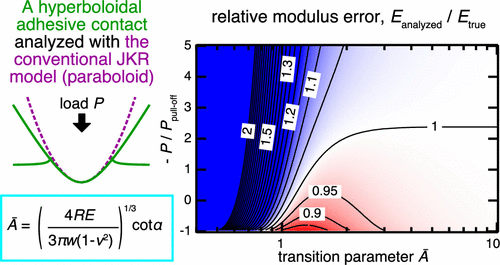Our official English website, www.x-mol.net, welcomes your
feedback! (Note: you will need to create a separate account there.)
Cone-Paraboloid Transition of the Johnson-Kendall-Roberts-Type Hyperboloidal Contact.
Langmuir ( IF 3.7 ) Pub Date : 2020-08-29 , DOI: 10.1021/acs.langmuir.0c01943 So Fujinami 1 , Ken Nakajima 2, 3
Langmuir ( IF 3.7 ) Pub Date : 2020-08-29 , DOI: 10.1021/acs.langmuir.0c01943 So Fujinami 1 , Ken Nakajima 2, 3
Affiliation

|
Atomic force microscopy (AFM)-based nanoindentation technique has been widely used to investigate the mechanical properties of compliant specimens. When a sharp probe is indented into a soft and adhesive specimen, not only the rounded end of the probe but also the pyramidal base may be in contact. However, even in such a case, a contact model that assumes a paraboloidal tip geometry (the Hertz model or one of its expansions) is mainly employed to derive the mechanical properties; the error on the mechanical properties induced by the inaccurate tip geometry assumption has not been systematically clarified. Therefore, the focus of this work was put on quantifying this error with the assumption that the actual contact occurs between a hyperboloidal indenter and an elastic and adhesive sample surface. We demonstrated that the cone–paraboloid transition of the indentation curve is governed by a single parameter, A̅ = [4RE/3πw(1 – ν2)]1/3cotα, where E and ν are Young’s modulus and Poisson’s ratio of the specimen, respectively, R and α are the curvature radius and half-angle of the indenter, respectively, and w is the work of adhesion. Employing the general two-point method, we quantified the errors on elasticity and surface energy caused by the assumption of the paraboloidal and conical Johnson–Kendall–Roberts (JKR) models as functions of A̅ and the normalized load. AFM force measurements with cantilevers of different radii supported this A̅ dependency. These results showed unsuitable geometry assumption can give a large error, which is generally more serious than those caused by inappropriate choice of the adhesive interaction from the JKR and DMT (Derjaguin–Muller–Toporov). It can be said that the conical model gives a good approximation to a hyperboloidal contact when A̅<1 and so does the paraboloidal model when A̅>4. A̅ is expected to be an important index that validates the paraboloidal and conical approximation in a soft and adhesive contact.
中文翻译:

Johnson-Kendall-Roberts型双曲面接触的锥-抛物面过渡。
基于原子力显微镜(AFM)的纳米压痕技术已被广泛用于研究顺应试样的机械性能。当将尖锐的探针压入柔软且具有粘性的样本中时,不仅探针的圆形端部也可能与金字塔形底部接触。但是,即使在这种情况下,也主要采用假定抛物线形尖端几何形状的接触模型(赫兹模型或其扩展之一)来得出机械性能。由尖端几何形状假设不正确引起的机械性能误差尚未得到系统地澄清。因此,这项工作的重点是在假设实际接触发生在双曲面压头与弹性和粘性样品表面之间的前提下,对这一误差进行量化。一个= [4 RE / 3 πw(1 - ν 2)] 1/3婴儿床α,其中È和ν是杨氏模量和试样,分别的泊松比,- [R和α是的曲率半径和半角压头分别与w是粘着功。使用一般的两点法,我们量化了抛物面和圆锥形约翰逊-肯德尔-罗伯茨(JKR)模型作为A̅函数的假设所引起的弹性和表面能误差和归一化的负载。具有不同半径的悬臂的AFM力测量结果支持了这种A̅依赖性。这些结果显示不合适几何形状的假设可以给一个大的误差,这通常比那些由从JKR和DMT(Derjaguin -穆勒-Toporov)粘合剂相互作用的选择不当更为严重。可以说,当A̅ <1时,圆锥模型可以很好地近似双曲面接触,当A when > 4时,抛物面模型也可以。预期A̅是验证软性和粘性接触中抛物面和圆锥近似的重要指标。
更新日期:2020-09-29
中文翻译:

Johnson-Kendall-Roberts型双曲面接触的锥-抛物面过渡。
基于原子力显微镜(AFM)的纳米压痕技术已被广泛用于研究顺应试样的机械性能。当将尖锐的探针压入柔软且具有粘性的样本中时,不仅探针的圆形端部也可能与金字塔形底部接触。但是,即使在这种情况下,也主要采用假定抛物线形尖端几何形状的接触模型(赫兹模型或其扩展之一)来得出机械性能。由尖端几何形状假设不正确引起的机械性能误差尚未得到系统地澄清。因此,这项工作的重点是在假设实际接触发生在双曲面压头与弹性和粘性样品表面之间的前提下,对这一误差进行量化。一个= [4 RE / 3 πw(1 - ν 2)] 1/3婴儿床α,其中È和ν是杨氏模量和试样,分别的泊松比,- [R和α是的曲率半径和半角压头分别与w是粘着功。使用一般的两点法,我们量化了抛物面和圆锥形约翰逊-肯德尔-罗伯茨(JKR)模型作为A̅函数的假设所引起的弹性和表面能误差和归一化的负载。具有不同半径的悬臂的AFM力测量结果支持了这种A̅依赖性。这些结果显示不合适几何形状的假设可以给一个大的误差,这通常比那些由从JKR和DMT(Derjaguin -穆勒-Toporov)粘合剂相互作用的选择不当更为严重。可以说,当A̅ <1时,圆锥模型可以很好地近似双曲面接触,当A when > 4时,抛物面模型也可以。预期A̅是验证软性和粘性接触中抛物面和圆锥近似的重要指标。











































 京公网安备 11010802027423号
京公网安备 11010802027423号